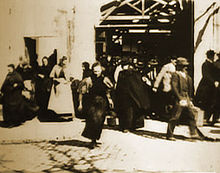- Workers Leaving the Lumière Factory
-
Workers Leaving the Lumiere Factory in Lyon 
Screencap from Workers Leaving the Lumiere Factory in LyonDirected by Louis Lumière Produced by Louis Lumière Cinematography Louis Lumière Distributed by Lumière Release date(s)  March 22, 1895
March 22, 1895
 February 20, 1896
February 20, 1896
 March 22, 1970 (TV premiere)
March 22, 1970 (TV premiere)Running time 46 seconds Country France Language Silent Workers Leaving The Lumière Factory in Lyon (also known as La Sortie des usines Lumière à Lyon (original title), Employees Leaving the Lumière Factory and Exiting the Factory (US titles) is an 1895 French short black-and-white silent documentary film directed and produced by Louis Lumière. It is often referred to as the first real motion picture ever made[1], although Louis Le Prince's 1888 Roundhay Garden Scene pre-dated it by seven years.
Contents
Plot
The film consists of a single scene in which workers leave the Lumiere factory. The workers are mostly female who exit the large building 25 rue St. Victor, Montplaisir on the outskirts of Lyon, France, as if they had just finished a day's work.
Three separate versions of this film exist. There are a number of differences between these, for example the clothing style changes demonstrating the different seasons in which they were filmed. They are often referred to as the "one horse," "two horses," and "no horse" versions, in reference to a horse-drawn carriage that appears in the first two versions (pulled by one horse in the original and two horses in the first remake).[2]
Production
This 46-second movie was filmed in Lyon, France, by Louis Lumière. It was filmed by means of the Cinématographe, an all-in-one camera, which also serves as a film projector and developer. This film was shown in 1895 at the Grand Café on the Boulevard des Capucines in Paris, along with nine other short movies.
As with all early Lumière movies, this film was made in 35 mm format with an aspect ratio of 1.33:1, and at a speed of 16 frames per second. At that rate, the 17 meters of film length provided a duration of 46 seconds, holding a total of 800 frames.[3]
Current status
Given its age, this short film is available to freely download from the Internet. It has also featured in a number of film collections including Landmarks of Early Film volume 1 and The Movies Begin - A Treasury of Early Cinema, 1894–1913
The film has been known by a large number of alternative titles in France and the United States over the years since its production including La Sortie des Usines Lumière à Lyon-Montplaisir, Sortie de l’Usine Lumière, La Sortie des Usines, Les ouvriers et ouvrières sortant de l’Usine Lumière, Employees Leaving the Lumière Factory, Leaving the Factory, Workers Leaving the Lumière Factory, Lunch Hour at the Lumière Factory, Dinner Hour at the Factory Gate of M. Lumière at Lyon, Exiting the Factory, La Sortie des ouvriers de l'usine Lumière.[4][5]
References
- ^ "Lumière" (HTML). Microsoft Encarta Online Encyclopedia 2007. http://encarta.msn.com/encyclopedia_761573634/Lumi%C3%A8re.html. Retrieved 2007-03-18.[dead link]
- ^ "Alternative titles" (HTML). Internet Movie Database. http://www.imdb.com/title/tt0000010/alternateversions. Retrieved 2007-03-18.
- ^ Chardère (1985), p.71,81,107,109.
- ^ "Alternative Titles" (HTML). Internet Movie Database. http://www.imdb.com/title/tt0000010/releaseinfo. Retrieved 2007-03-18.
- ^ "La Sortie des Ouvriers de l’Usine Lumière" (HTML). Silent Era. Archived from the original on October 21, 2006. http://web.archive.org/web/20061021125407/http://www.silentera.com/PSFL/data/S/SortiedesOuvriersdelUs1895.html. Retrieved 2007-03-18.
Sources
- Chardère, B.; Borgé, G. and M. (1985). Les Lumière, Paris: Bibliothèque des Arts. ISBN 2-85047-068-6 (French)
See also
- List of films in the public domain
- Roundhay Garden Scene
External links
- Institut-lumiere.org , an earlier version (in very low definition) at the Institut Lumière.
- YouTube.com, The "two horse" version.
- YouTube.com, The "no horse" version.
- Workers Leaving the Lumiere Factory at the Internet Movie Database
Films by Auguste and Louis Lumière 1895 La Sortie de l'usine Lumière à Lyon – La Voltige – La Pêche aux poissons rouges – Le Débarquement du congrès de photographie à Lyon – Les Forgerons – L'Arroseur Arrosé – Le Repas de bébé – Le Saut à la couverture – La Place des Cordeliers à Lyon – La Mer (Baignade en mer) –1896 Cinema of France Actors · Directors · Cinematographers · Editors · Films A-Z · Producers · Score composers · Screenwriters · Film festivals
Films by year: 1892–1909 · 1910 · 1911 · 1912 · 1913 · 1914 · 1915 · 1916 · 1917 · 1918 · 1919 · 1920 · 1921 · 1922 · 1923 · 1924 · 1925 · 1926 · 1927 · 1928 · 1929 · 1930 · 1931 · 1932 · 1933 · 1934 · 1935 · 1936 · 1937 · 1938 · 1939 · 1940 · 1941 · 1942 · 1943 · 1944 · 1945 · 1946 · 1947 · 1948 · 1949 · 1950 · 1951 · 1952 · 1953 · 1954 · 1955 · 1956 · 1957 · 1958 · 1959 · 1960 · 1961 · 1962 · 1963 · 1964 · 1965 · 1966 · 1967 · 1968 · 1969 · 1970 · 1971 · 1972 · 1973 · 1974 · 1975 · 1976 · 1977 · 1978 · 1979 · 1980 · 1981 · 1982 · 1983 · 1984 · 1985 · 1986 · 1987 · 1988 · 1989 · 1990 · 1991 · 1992 · 1993 · 1994 · 1995 · 1996 · 1997 · 1998 · 1999 · 2000 · 2001 · 2002 · 2003 · 2004 · 2005 · 2006 · 2007 · 2008 · 2009 · 2010 · 2011
Categories:- 1895 films
- Black-and-white films
- Films set in Lyon
- French films
- Short films
- Silent films
- Films directed by Auguste and Louis Lumière
- 1890s documentary films
Wikimedia Foundation. 2010.
